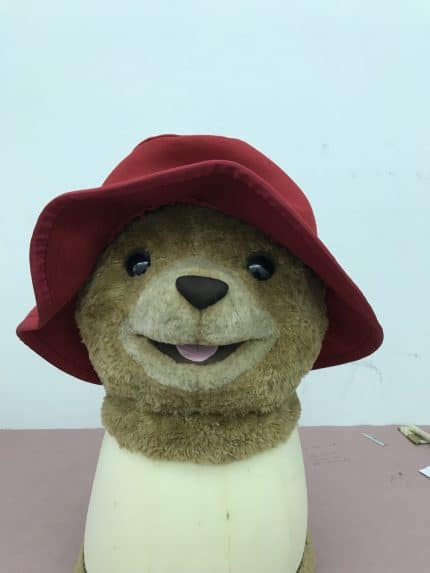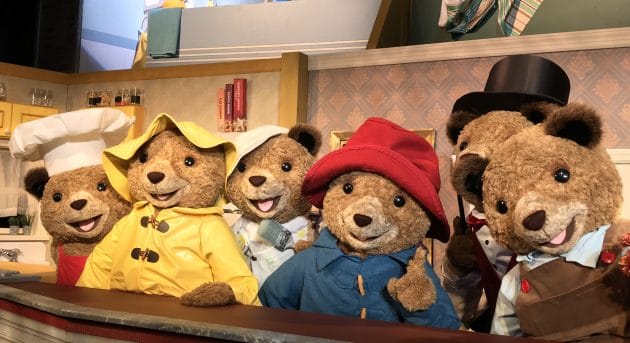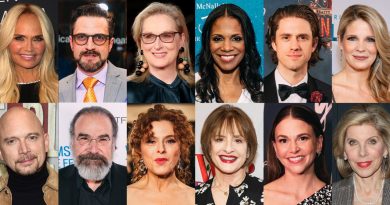Drama Desk Award nominees Laura Manns & Vito Leanza discuss their passion for puppetry
Following the announcement that Rockefeller Productions has received a 2020 Drama Desk Award nomination for Best Puppetry Design in their production of Paddington Gets In a Jam, I wanted to find out more about the process from Laura Manns (puppet designer) & Vito Leanza (puppet builder).
Please tell me a little bit about yourselves:
LAURA: I grew up in Europe, South America, and Asia. Since childhood, I’ve always loved creating and was enamoured by the things I grew up watching, from Disney animations to fantasy movies. I’ve carried my love for anthropomorphic animals into my work as a puppet and prop builder and, most recently, a doll maker. Over the past decade, I’ve had the opportunity to work for some of the companies that I grew up admiring like the Jim Henson Company, Nickelodeon, and Disney.
VITO: I’m a singer/dancer/actor/acrobat/puppeteer/stilt walker/unicyclist/juggler/writer/costume designer. After college and travelling the world, I worked at Walt Disney World as a parade performer and a character performer. After that stint, I got a job at a mascot and puppet builders shop. In 2014 I was recruited by one of my clients Bonnie Erickson, the creator of Miss Piggy to conserve over 500 puppets, props and costumes donated by Jim Henson’s family, for the Jim Henson wing in the Worlds of Puppetry Museum at the Center for Puppetry Arts.
When did you first become interested in the art of puppetry?

VITO: As a kid, I made simple puppets, but it wasn’t until I was working at Walt Disney World that I became a puppeteer. I took that skill with me to NYC and was hired by Larry Engler of Poko Puppets and performed with his shows for 10 years.
What is your favourite example of puppetry in a piece of live theatre?
LAURA: The ‘King Kong’ puppet is a breathtaking marvel of engineering by Creature Technology Company. To call it a marionette would be simplifying it, but it is a puppet on strings even though it is operated by 15 people, with animatronic facial expressions, and standing at 20 feet tall. The sheer size of it and uncanny movements make it scary and riveting!
VITO: I am always in awe of the beauty of marionette Puppetry. It’s the one form of Puppetry I’d love to learn.
Tell me a little about the process of creating the Paddington puppet?

VITO: Laura built the first ‘master’ Paddington puppet, and it was my job to replicate him to create the six versions actually used in the show (the master version is not used). Every costume change Paddington makes requires another puppet, as Paddington often changes costume mid-scene, and within seconds at that, and there isn’t time to do this off stage. I redesigned much of the inside of the puppet, using stronger and longer-lasting materials that were also lighter. I fixed mechanisms that allowed the 
What were some of the challenges you faced?
LAURA: At first he wasn’t cute enough! I was near finishing Paddington up and something wasn’t quite right; he had more of a grown-up bear appearance. I played around with bigger eyes, repositioning the nose, but couldn’t figure it out. After a moment away from him, I came back and realized what it was: his snout was too big. I shrunk the snout which in turn made all his facial features come in towards the centre of his face, therefore making his forehead bigger and perhaps giving a slightly more infantile appearance. Tiny tweaks sometimes make a big difference.
VITO: My biggest challenge was that the original puppet was in being used in rehearsals in New York City while I was deciphering patterns half a world away. During the rehearsal process, the production team 
Why do you think puppetry is important in theatre?
LAURA: I remember seeing War Horse and by the end forgetting it was a puppet. Puppets are essential from a logistical standpoint; you can’t have a horse perform daily, on cue, on stage. And they are also necessary in the sense that actors can’t take their place (no matter how hard you try, an actor is not a horse!). There is something kind of magical about knowing a puppet is being
operated by human hands, but believing it wholeheartedly.
VITO: Puppets bring a new kind of life to any stage production or film. They do things that humans can’t do, yet they can still make us laugh, cry, sing and dance.
Is there a production you’d love to see adapted to include puppetry and why do you think the puppetry would add to the storytelling?
LAURA: I’m actually surprised that The Nightmare Before Christmas hasn’t been adapted for the stage yet. The characters in the movie would allow for the most dynamic puppets: from flying bats to ghosts, to singing pumpkins, to a fleet of skeleton reindeer. I mention this because it would be an incredible production to work on!
VITO: I think any animated film, especially those that feature animals and inanimate objects, would translate beautifully to a stage or film. Puppetry lends itself very well to fantastical stories, in which there are dragons, elves, goblins, and other fantastical creatures. Puppets also immerse children and adults alike into a story, allowing the characters to come to life and relatable.
What’s next for you?
LAURA: The current working climate has given me the opportunity to work on personal projects which I ordinarily wouldn’t have much time for. Most recently I’ve been creating poseable animal dolls with fully articulated armatures. It’s been liberating to work without deadlines and I’m enjoying the challenge of working with the materials I already have on hand.
VITO: While the world is on hold for more Paddington’s and Puppets in other stage productions, parades, films and television, I am feverishly (no pun intended) making hundreds of masks to protect my friends and family from the coronavirus. For now, there’s nothing more important.




